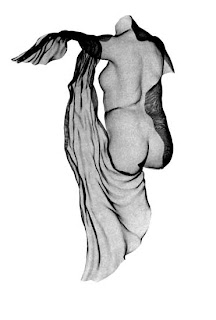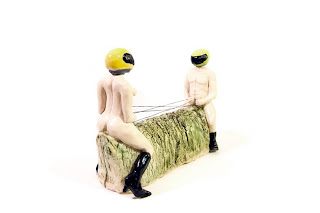 | |||
| Works from the Butterflies series - Copyright of Cecelia Webber |
What do I mean by unique? Are all artists not unique? Well, all artists of course have a unique human personality but it is much harder to find a new visual language in which to express personal vision and ideas. Standing out as a unique artist by finding a unique artistic method and style of expression and making a new contribution to the world of art is arguably one of the greatest challenges an artist faces.
Although the aim of art is to explore and to present cutting edge visions and ideas there are still a lot of mediocre artists around who do not fulfill this aim. Likewise there are thousands even hundreds of thousands of photographers in the world today working with art photography.
Some photographers approach their medium with the primary goal of mastering its complex and scientific techniques, do so and go on to produce masterful and technically perfect pictures. But mastering the complex techniques of photography does not mean that you can call your work art and indeed many ‘art photography’ pictures are devoid of artistic vision or emotion.
Yet in spite of this it is also evident when you come across a truly talented artist who uses photography as her or his medium. Webber is one such artist. and her work is interesting because she experiments with photography and digital manipulation in order to express her artistic vision.
In art historical terms artists would traditionally use a medium the likes of oil, acrylics, watercolour, pencil, pastels etc. applied to canvas, board, paper etc. With the advent of the digital age comes the possibility and rise of digital art.
Whereas art traditionally has been based on an artist’s draughtsmanship i.e. his ability to sketch draw and paint by hand, the creation of digital art instead relies heavily on an understanding and use of digital media. So whereas you might define traditional art as based on an individual’s draughtsmanship presented on a canvas, digital art is based on an artist working with digital manipulation of information presented in a digital format.
The interesting thing here is that the photo and imaging editing software used in order to digitally manipulate information opens up possibilities for an artist that is not otherwise possible. This means that artists can start exploring and blazing new trails in artistic terms and that is exactly what Webber is doing with her experimental digital photography art work.
The experimental art of Cecelia Webber.
Webber's digital art is at the cutting edge because she creates a balance by linking the digital medium with the sensual aspects of the natural world.
 |
| Purple Flower (Flowers series) - Copyright of Cecelia Webber |
Webber’s Flowers and Butterflies series.
Webber has chosen to work with two different themes so far for her experimental photography series, one called Flowers the other Butterflies.
Blue Lilac is from her Flower series and is a perfect example of how you may not see the human form that makes up the petals of the lilac at first glance.
 |
| Blue Lilac (Flowers series) - Copyright of Cecelia Webber |
White Dandelion is another imaginative example of Webber’s artistic approach. Here she creates a stunning visual resemblance of the delicate flower we all know so well. But the real charm of this image is in the single white puffy seed flying away cause it takes us back to those childhood days where blowing on a dandelion and seeing the seeds fly away was a source of endless joy.
 |
| White Dandelion (Flowers series) - Copyright of Cecelia Webber |
In most of Webber’s works you do not see the complete naked human form. In Webber’s work Rose however, she breaks up and uses the naked female human form to make up the stem and crown of a rose but also depicts an intact naked female right at the centre of the rose. Apart from pointing to the source of her work, much like a painter might smear a thick layer of paint on a canvas with a spatula, seeing a whole naked female in the centre of a flower also draws parallels to a well established tradition of linking a delicate flower with female sensuality.
 |
| Rose (flowers series) - Copyright of Cecelia Webber |
Sprouting Seed is another ingenious work of Webber’s that shows her artistic depth. Webber has again used the female form to create her scene of a sprouting seed seen both above and below ground. The image clearly references the link between the female and that of fertility and germination. And of course we all know that new life is generated through the union between male and female.
 |
| Sprouting Seed (flowers series) - Copyright of Cecelia Webber |
I also want to briefly mention and show Webber’s work Bird of Paradise because here she uses a male model instead of a female model to illustrate the flower with stunning visual effect.
 |
| Bird of Paradise (flowers series) - Copyright of Cecelia Webber |
As visually stunning as the Flower series but perhaps more complex is Webber’s Butterflies series.
Monarch and Vivid are both complex images of colourful butterflies made up of the human form. When you look closely at the images you can clearly see the naked human forms that unify to create the image of a butterfly but in Reach, Webber’s image of a caterpillar hanging off a twig, it is much harder to distinguish the human form.
 | ||
| Monarch (butterflies series) - Copyright of Cecelia Webber |
 |
| Vivid (Butterflies series) - Copyright of Cecelia Webber |
 |
| Reach (Butterflies series) - Copyright of Cecelia Webber |
Webber has produced a number of works but not a single one that I don’t really like. I would strongly urge you to explore Webber’s website and particularly encourage you to look at Marple, Yellow Lily, Summer Dandelion, Bell Peppers, Fiddlehead and Bleeding Heart.
To purchase one of Webber’s works please contact jared@ceceliawebber.com
Cecelia Webber: I enjoy the challenge of making something beautiful and simple looking out of the complicated shape of the human body.
EAL: You have previously remarked on the importance of the human body: “Why are we made to feel so ashamed of the human body in Western culture and so much of the rest of the world? Isn’t the body a beautiful, wonderful thing, deserving nothing less than to be celebrated?”. If your images are a celebration of the human form why have you chosen to illustrate other creatures of nature?
CW: I want to distract people from the nudity a little, so that it can be better appreciated. I want people to see the body in a new way. It’s hard to get people to really look at something in detail, and I think that the complexity of the pieces allows people to look closer at the body without feeling self conscious doing so. It’s different than looking at a nude portrait. Also though, I just enjoy making the pieces that way, and that’s the biggest reason why I do it.
EAL: What gave you get the idea of using the human body to create the form of butterflies and flowers?
CW: I once took a nude portrait of my back for another project, and it looked so much like a petal that I dropped the first idea and started working on this one right away.
EAL: What visual image should a viewer of your work pay more attention to, the human body or the flower or butterfly?
CW: It’s an aesthetic series, made – from my perspective – largely for the experiences I get out of making it. People can choose for themselves what to focus on, depending on what they find interesting about it.
EAL: I think people are often unaware of the complex and time-consuming process behind a digital work of art. Can you explain a bit about your work process for making a piece like Monarch from the Butterflies Series?
CW: Sometimes the pieces take up to two months to produce – first I shoot all the poses involved, edit them out of their background, which is very time consuming, then I go and shape the composition, at which point I often realize I need to reshoot one of my poses. I am currently in the process of remaking old pieces I made with a lower quality camera, and to remake them even is a huge, time-consuming challenge. I’m happy when a finished piece looks simple to the viewer though, because that means I’ve done my job right. It’s not easy to make something shaped out of human body photos look simple.
EAL: You sell your print mounted between clear acrylic on the face and black acrylic on the back. What is your reason for not letting your clients make their own choice regarding how they feel the print should be framed?
CW: There are a lot of complications with selling limited series. As the artist, I’d like my work to be accessible to anyone however they want it, but as somebody hoping to live off of art one day as a career, I have to standardize to a certain extent to cope with the nature of the art world. Basically, my art is limited edition art work. For something to be considered a limited edition, you have to specify what is limited, how many there are, and what kind of things they are. I also want to offer posters, but if I was to now I’ve been told it would compromise my limited edition work and mean I can’t sell my art in most galleries. It’s far more complicated than I want it to be. In the future I will offer selected works at an affordable price point so everybody who likes my art can own it, and that is something that is being actively worked on at the moment.
EAL: Can you tell us about your next project or series?
CW: It will involve birds
Did you enjoy this post? Do you want to see and hear more about artists working with erotic art?
If you visit eroticartlover.com you can sign-up to our newletter where we keep our subscribers up to date with information about upcoming talks and lectures about erotic art. We´ll also let you know every time there is a new post on the blog.



























































